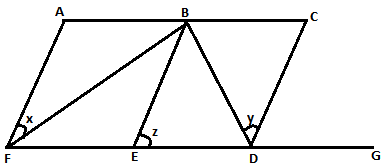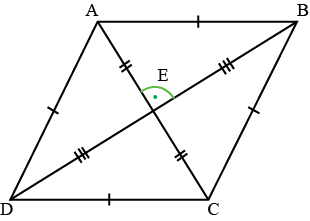9th Grade > Mathematics
QUADRILATERALS MCQs
Total Questions : 57
| Page 3 of 6 pages
Answer: Option B. -> False
:
B
A rhombus can be considered as a parallelogram with all sides equal. Hence its adjacent angles are supplementary, whereas a kite does not have any sides parallel and thus its adjacent angles need not be supplementary.
:
B
A rhombus can be considered as a parallelogram with all sides equal. Hence its adjacent angles are supplementary, whereas a kite does not have any sides parallel and thus its adjacent angles need not be supplementary.
:
Trapezium is a quadrilateralin which only one pair of opposite sides is parallel.
Answer: Option B. -> Square
:
B
A regular quadrilateral is a shape that has four equal sideswith all the interior angles equal.
Among the given options, only square has all its four sides equal with each angle being 90∘.
:
B
A regular quadrilateral is a shape that has four equal sideswith all the interior angles equal.
Among the given options, only square has all its four sides equal with each angle being 90∘.
Answer: Option B. -> 60∘, 80∘, 100∘, 120∘
:
B
The angles of a quadrilateral are in the ratio3:4:5:6.
Let the angles of the quadrilateralbe 3x,4x,5x,6x.
The sum of the angles of aquadrilateral is 360∘.
⇒3x+4x+5x+6x=360∘
⇒18x=360∘
⇒x=20∘
∴3x=60∘,4x=80∘,5x=100∘,6x=120∘
:
B
The angles of a quadrilateral are in the ratio3:4:5:6.
Let the angles of the quadrilateralbe 3x,4x,5x,6x.
The sum of the angles of aquadrilateral is 360∘.
⇒3x+4x+5x+6x=360∘
⇒18x=360∘
⇒x=20∘
∴3x=60∘,4x=80∘,5x=100∘,6x=120∘
Answer: Option A. -> True
:
A

Suppose ABCD is a parallelogram and BD is the diagonal.
There are two triangles - Δ ABD and Δ CDB
In Δ ABD and Δ CDB,
AD = BC (opposite sides of a parallelogram are equal)
AB = CD (opposite sides of a parallelogram are equal)
BD is common
∴ By SSS criterion of congruency,
Δ ABD ≅ Δ CDB
Hence, the given statement is true.
:
A

Suppose ABCD is a parallelogram and BD is the diagonal.
There are two triangles - Δ ABD and Δ CDB
In Δ ABD and Δ CDB,
AD = BC (opposite sides of a parallelogram are equal)
AB = CD (opposite sides of a parallelogram are equal)
BD is common
∴ By SSS criterion of congruency,
Δ ABD ≅ Δ CDB
Hence, the given statement is true.
Answer: Option A. -> True
:
A
A parallelogram is made up of two triangles, each having an area equal to the halfof the product of base and corresponding height. Adding these two, we find the given statement to be true.
:
A
A parallelogram is made up of two triangles, each having an area equal to the halfof the product of base and corresponding height. Adding these two, we find the given statement to be true.
Answer: Option B. ->
Circle
:
B
:
B
A quadrilateral is a polygon with four sides and four vertices.
A quadrilateral has four sides, four angles and four vertices. Square, trapezium and rhombus are quadrilaterals. A circle can be approximated as a polygon with infinite sides but it is not a polygon.
It is because a polygon must have straight edges (sides). A circle doesn't have straight sides.
Answer: Option B. ->
False
:
B
:
B
Sum of all angles of a quadrilateral is 360∘.
Fourth angle=360∘−(75∘+90∘+75∘)=120∘
Since the pairs of opposite angles of a parallelogram are equal, this quadrilateral cannot be a parallelogram since it has three different angles and only one pair of equal angles.

















